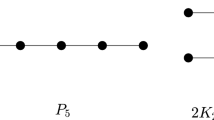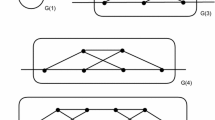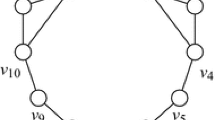Abstract
A cycle C in a graph G is dominating if every edge of G is incident with at least one vertex of C. For a set \(\mathcal {H}\) of connected graphs, a graph G is said to be \(\mathcal {H}\)-free if G does not contain any member of \(\mathcal {H}\) as an induced subgraph. When \(|\mathcal {H}| = 2, \mathcal {H}\) is called a forbidden pair. In this paper, we investigate the characterization of the class of the forbidden pairs guaranteeing the existence of a dominating cycle and show the following two results: (i) Every 2-connected \(\{P_{5}, K_{4}^{-}\}\)-free graph contains a longest cycle which is a dominating cycle. (ii) Every 2-connected \(\{P_{5}, W^{*}\}\)-free graph contains a longest cycle which is a dominating cycle. Here \(P_{5}\) is the path of order \(5, K_{4}^{-}\) is the graph obtained from the complete graph of order 4 by removing one edge, and \(W^{*}\) is the graph obtained from two triangles and an edge by identifying one vertex in each.







Similar content being viewed by others
References
Bedrossian, P.: Forbidden subgraph and minimum degree conditions for Hamiltonicity. Ph.D. Thesis, Memphis State University (1991)
Broersma, H.J., Veldman, H.J.: Restrictions on induced subgraphs ensuring Hamiltonicity or pancyclicity of \(K_{1, 3}\)-free graphs. In: Bodendiek, R. (ed.) Contemporary Methods in Graph Theory, pp. 181–194 (1990)
Chiba, S., Furuya, M., Tsuchiya, S.: Forbidden pairs and the existence of a dominating cycle. Discrete Math. 338, 2442–2452 (2015)
Diestel, R.: Graph Theory, Fourth edition. Graduate Texts in Mathematics, vol. 173. Springer, Heidelberg (2010)
Duffus, D., Gould, R.J., Jacobson, M.S.: Forbidden subgraphs and the hamiltonian theme. The theory and applications of graphs, pp. 297–316. Wiley, New York (1981)
Faudree, R.J., Gould, R.J.: Characterizing forbidden pairs for Hamiltonian properties. Discrete Math. 173, 45–60 (1997)
Gould, R.J., Jacobson, M.S.: Forbidden subgraphs and Hamiltonian properties of graphs. Discrete Math. 42, 189–196 (1982)
Olariu, S.: Paw-free graph. Inf. Process. Lett. 28, 53–54 (1988)
Acknowledgments
The authors are grateful to referees for their helpful comments.
Author information
Authors and Affiliations
Corresponding author
Additional information
This work was partially supported by JSPS KAKENHI Grant Number 26800083.
Rights and permissions
About this article
Cite this article
Chiba, S., Furuya, M. & Tsuchiya, S. Dominating Cycles and Forbidden Pairs Containing \(P_{5}\) . Graphs and Combinatorics 32, 1773–1788 (2016). https://doi.org/10.1007/s00373-015-1673-8
Received:
Revised:
Published:
Issue Date:
DOI: https://doi.org/10.1007/s00373-015-1673-8




